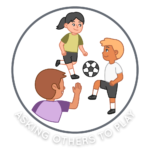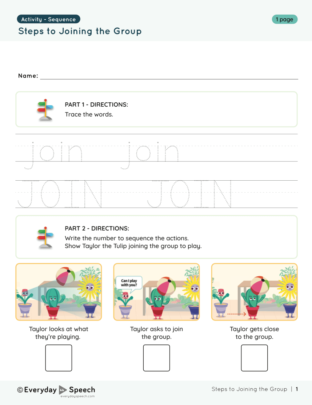
As educators working with preschoolers, we understand the importance of socialization and play skills development. One critical aspect of social interaction for young children is learning how to successfully join a group. By equipping children with the necessary tools to join and engage with peers effectively, we empower them to build lasting friendships, boost self-confidence, and foster a sense of belonging.
In this blog post, we will explore a comprehensive preschool play skills lesson plan focused on teaching preschoolers how to improve their play skills by mastering the art of joining a group. This engaging and interactive lesson plan, coupled with a worksheet activity titled “Steps to Joining the Group” will provide your students with practical strategies to navigate social settings confidently.
Teaching Preschool Play Skills
Joining a Group Lesson Plan
Objective:
- To teach preschoolers how to successfully join a group during playtime.
- To develop socialization and play skills in young learners.
- To foster a sense of belonging, confidence, and positive peer interactions.
Materials Needed:
- “Steps to Joining the Group” worksheet (one copy per student)
- Visual aids (pictures or illustrations depicting group play)
- Props and costumes for the interactive group play activity
- Songs, stories, or interactive games for circle time
Warm-Up Activity: Circle Time
- Gather the students in a circle.
- Begin with a welcome song or greeting to create a positive and inclusive atmosphere.
- Engage the students in interactive games or activities that promote turn-taking and sharing. For example, “Pass the Talking Stick” or “Guess the Animal Sound.”
- Use this opportunity to reinforce listening skills and encourage students to take turns speaking.
Introduction to Group Play (Approximately 10 minutes)
- Discuss the importance of group play and its benefits for socialization and overall development.
- Show visual aids depicting children engaged in group play, emphasizing the joy and cooperation involved.
- Ask open-ended questions to stimulate discussion, such as “Why do you think it’s important to play with friends?” or “What do you like about playing in a group?”
Interactive Group Play Activity (Approximately 20 minutes)
- Set up an interactive play scenario, such as “Zookeepers” or “Superheroes.”
- Provide props and costumes for the children to use during the activity.
- Explain the roles and rules of the game, modeling appropriate behavior and communication.
- Encourage students to take turns, share ideas, and collaborate with their peers.
- Offer prompts and guidance as needed, ensuring that each child has an opportunity to join and participate in the group play.
Guided Practice with “Steps to Joining the Group” Worksheet (Approximately 15 minutes)
- Distribute the “Steps to Joining the Group” worksheet to each student.
- Explain the purpose of the worksheet, which is to reinforce the concepts covered during the lesson.
- Review each step on the worksheet, discussing what it means and providing examples.
- Encourage students to complete the worksheet independently, using pictures or words to represent each step.
- Circulate around the classroom to provide support and guidance as needed.
Extension Play Skills Activities and Reinforcement
Additionally, check out these reinforcement activities and ideas to improve carryover for this preschool play skills lesson plan!
- Facilitate additional activities that reinforce the concept of joining a group.
- Play cooperative games, such as “Musical Chairs” or “Duck, Duck, Goose,” emphasizing turn-taking and sharing.
- Encourage role-playing scenarios where students practice joining different groups and interacting with new friends.
- Provide positive feedback and praise for students who demonstrate the skills learned during the lesson.

Sample Video
Students learn best from watching real students their own age model skills. Try out this sample video-modeling lesson below. We offer our entire Social-Emotional Learning platform free for 30 days here!
Related Blog Posts:
Teaching PreK Students When to Say “Sorry” and How to Apologize Effectively
Animal Breathing for PreK Students: A Calming Corner Activity










